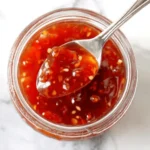Few kitchen projects are as rewarding as making your own hot sauce from scratch. Whether you enjoy a mild kick or a fiery punch, a homemade hot sauce recipe gives you full control over the taste and heat. With just a few simple ingredients, you can create something far better than most store-bought bottles.
In this guide, you’ll learn everything you need to make your own signature hot sauce. We’ll cover both fermented and non-fermented methods, show you how to tweak flavor and heat to your liking, and share tips for storage, safety, and creative uses. Whether you’re a first-timer or a chili lover looking to upgrade your skills, this guide is for you.
Table Of Contents
Why Make Your Own Hot Sauce?
- Quick to prepare and beginner-friendly
- Uses ingredients you likely already have
- Great for spicing up everyday meals or impressing guests
- Bold, rich flavor that beats anything off the shelf
- Customizable to match your personal taste
- Makes a thoughtful and unique homemade gift
What sets this recipe apart is the perfect balance between heat and flavor. It’s simple enough for first-timers yet adaptable for serious spice fans.
Homemade hot sauce isn’t just about heat. It’s about comfort, satisfaction, and creating something truly yours. When you use fresh peppers and natural ingredients, you get cleaner flavor and real depth. Plus, making it yourself means you know exactly what’s in your bottle.
It’s also easier on your wallet. A single batch can last for weeks, even months, and can be made in large or small quantities. Whether you’re cooking for yourself or sharing with friends, homemade hot sauce adds that personal touch you won’t find in store-bought brands.
Why Homemade Hot Sauce Stands Out
Flavor Superiority
When you make hot sauce yourself, the taste is instantly fresher and more complex. Store-bought versions often rely on preservatives and artificial flavors, while homemade sauce is built from real, vibrant ingredients. The flavor hits deeper and cleaner than anything you’ll find on a store shelf.
Customization
You get to control everything. Want more heat? Add hotter peppers. Prefer it milder? Blend in a sweet bell pepper. Like garlic or herbs? You decide the balance. You have full say over the taste, adjusting every batch to match what you like best.
Ingredient Control
You know what goes into your sauce. That means no fillers, additives, or excess salt. It’s cleaner, purer, and often healthier than commercial alternatives.
Cost-Effectiveness
A homemade batch costs less than buying premium brands and can be made using ingredients from your kitchen or garden. One small batch can go a long way.
The Satisfaction of DIY
Making your own sauce is rewarding. It’s a chance to be creative, try new flavors, and share something you made by hand. It also makes a memorable gift that feels personal and thoughtful.
Understanding Your Peppers: The Foundation of Flavor and Heat
What the Scoville Scale Tells You
The Scoville Scale is a guide that ranks peppers by how spicy they feel. It reflects the amount of natural heat-producing compounds inside each pepper, helping you compare one variety to another.
Heat Levels Across Pepper Types
- Mild to Medium: Jalapeño, Serrano, Fresno, Cherry Bomb, Banana Peppers
- Medium to Hot: Cayenne, Tabasco, Thai Chilies, Fish Peppers
- Intense to Fiery: Habanero, Scotch Bonnet, Ghost Pepper, and the famously powerful Carolina Reaper
Flavor Profiles of Popular Peppers
Heat is just one part of the story. Many peppers offer bold character. Habaneros bring a bright, fruity kick, while chipotles lend a rich, smoky note. Knowing the flavor side of each pepper helps you design a sauce with more than just spice.
Color Considerations
The color of your chilies will shape the final look and flavor of your sauce. Red ones often bring depth and sweetness. Green varieties feel fresh and sharp. Mixing both may lead to a brownish blend, so choose with your visual goal in mind.
Choosing the Best Peppers
Always go for peppers that feel firm and look vibrant. Skip anything soft or wrinkled. The most flavor comes from fully ripened chilies, especially those picked at peak season or fresh from your garden.
Ingredients Needed
Creating hot sauce at home starts with fresh, flavorful ingredients. Here’s what you’ll need, grouped by their role in the recipe:
For the Heat and Base
- 3 cups hot peppers, whole (choose based on your desired spice level)
- 1/4 cup red bell pepper or another sweet variety for balance
For the Flavor and Aroma
- 6 whole garlic cloves
- 1/3 cup fresh cilantro leaves
- 1/4 cup fresh mint leaves
For the Seasoning and Acidity
- 1 tablespoon coarse salt, such as kosher or sea salt
- 2 tablespoons vinegar, either white or white balsamic depending on your preference
For Texture and Preservation
- 1/4 cup extra virgin olive oil
Each ingredient adds something essential. The red bell pepper softens the heat. Garlic, herbs, and vinegar round out the flavor. Olive oil brings everything together and helps preserve the sauce in storage.
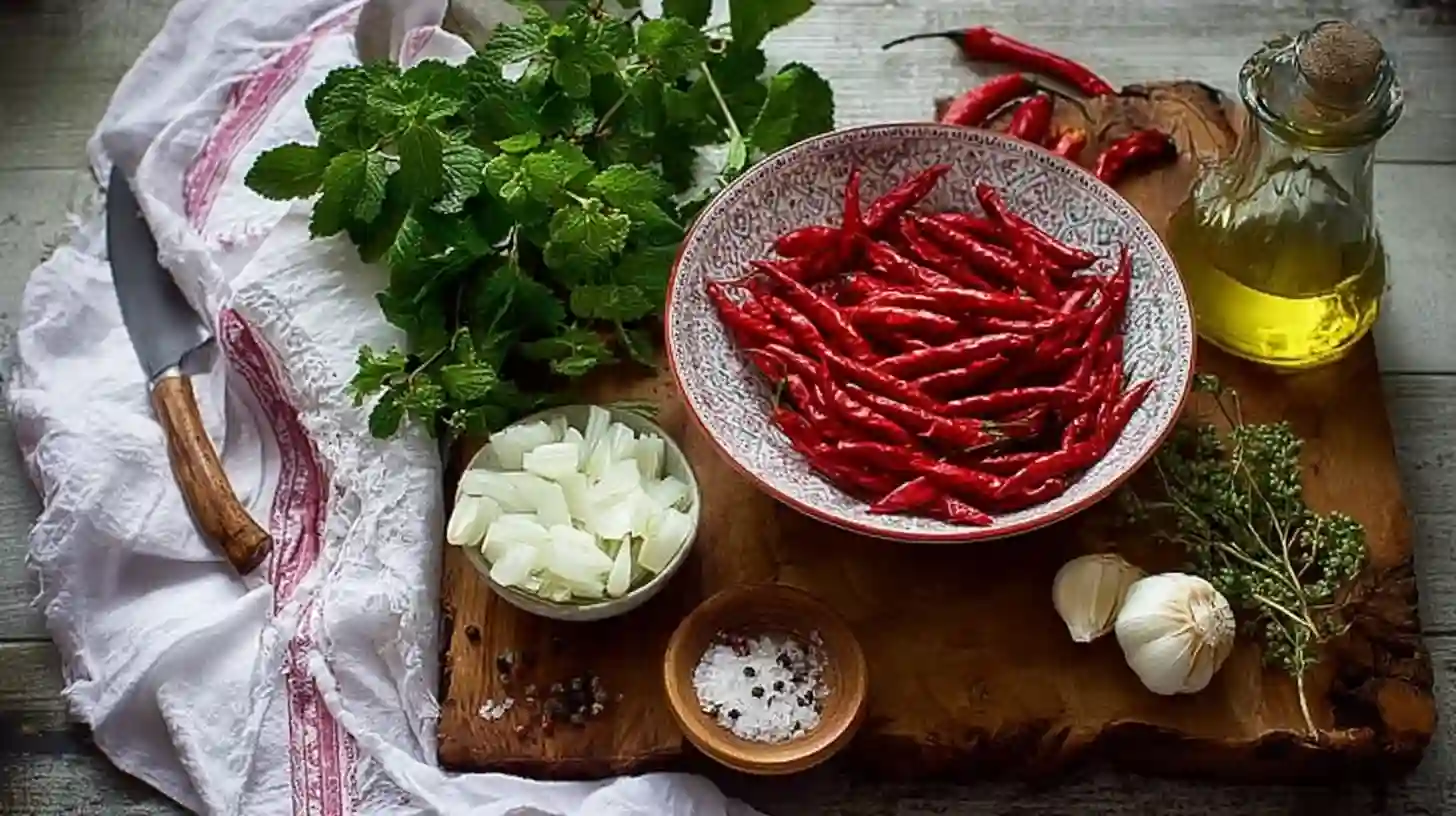
How to Make Hot Sauce at Home
Follow these easy steps to create a bold, fresh hot sauce that packs flavor and just the right amount of heat.
1.Prepare Your Ingredients
Rinse the peppers, herbs, and garlic. Remove stems from the hot peppers and the bell pepper. If you want a milder sauce, take out the seeds and white ribs from the hot peppers.
2.Blend Everything Together
Place the hot peppers, bell pepper, garlic, salt, vinegar, olive oil, cilantro, and mint into a food processor or high-speed blender. Blend until the mixture is chunky but blended enough to combine everything evenly. Avoid over-blending if you prefer a sauce with more texture.
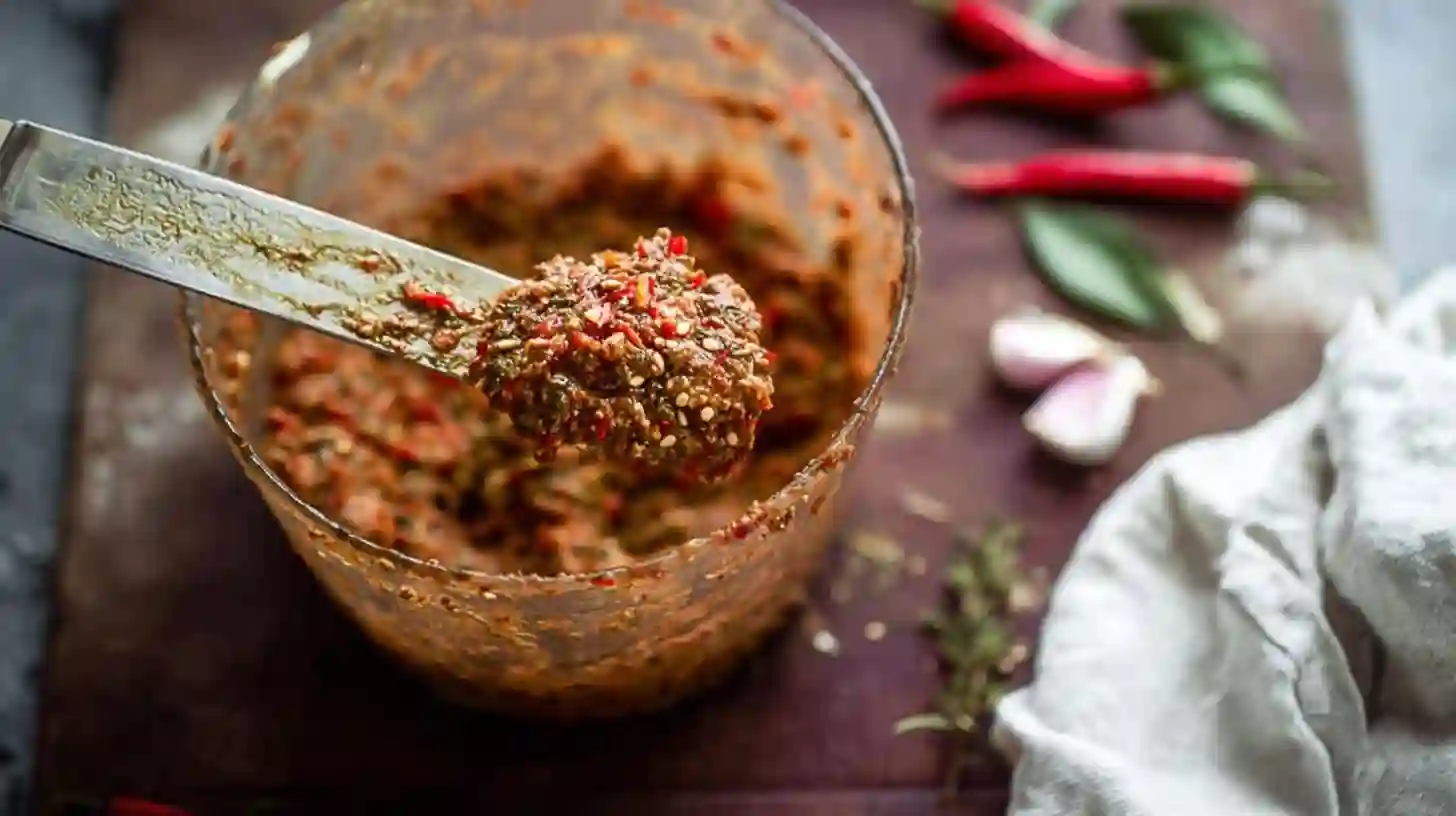
3.Transfer to a Jar
Spoon the mixture into a clean mason jar. Use a spatula to scrape down the sides and pack the sauce evenly into the container.
4.Add a Finishing Layer
Pour a thin layer of olive oil over the top of the sauce. This step helps protect the surface and extend the life of your hot sauce.
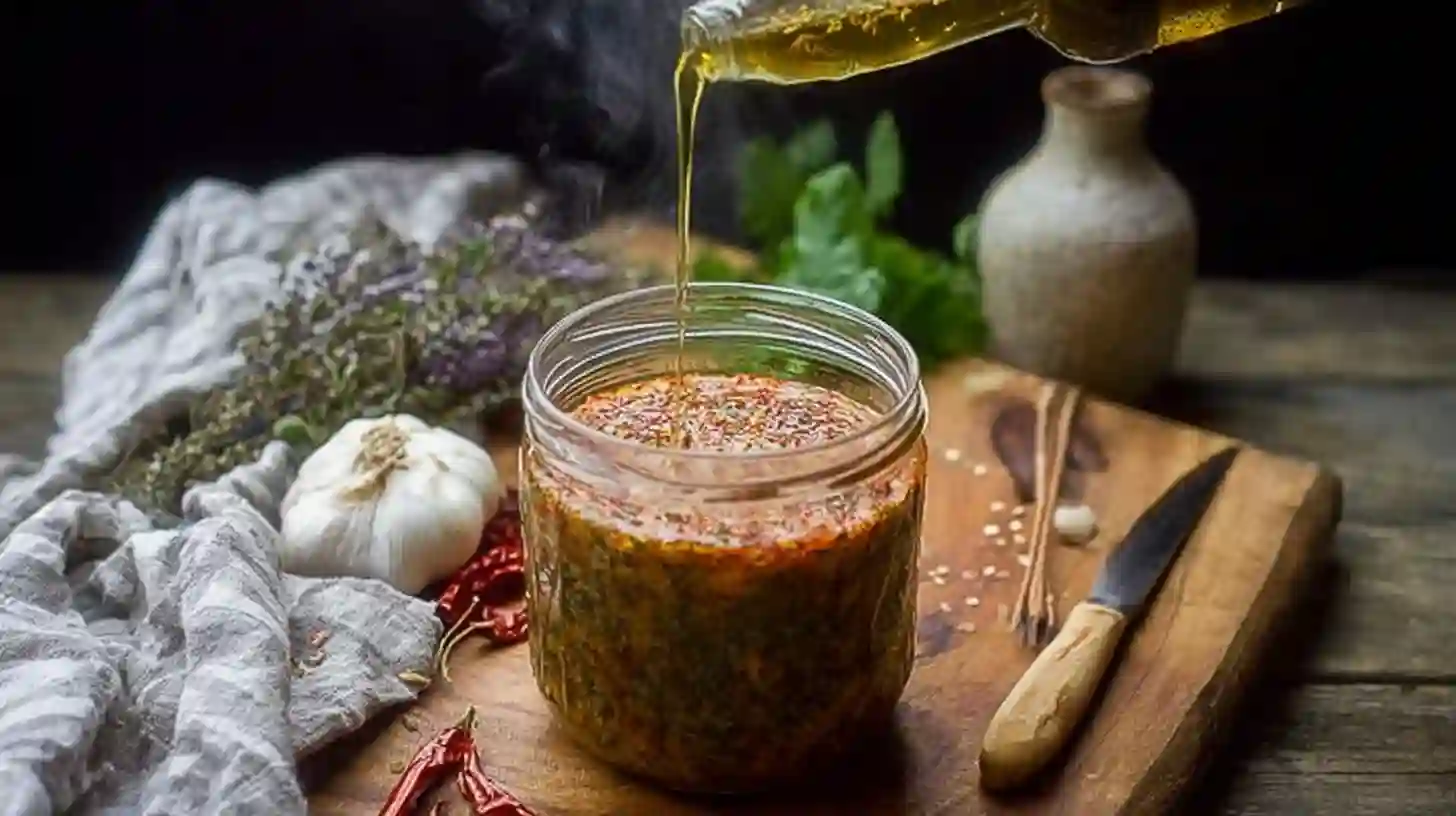
5.Chill and Let Flavors Develop
Seal the jar tightly and refrigerate. Allow the sauce to rest for at least 24 hours before using. This gives the flavors time to settle and blend.
6.Enjoy and Store
Your homemade hot sauce is ready. Use it to spice up meals or give it as a gift. It will stay fresh in the refrigerator for up to three months.
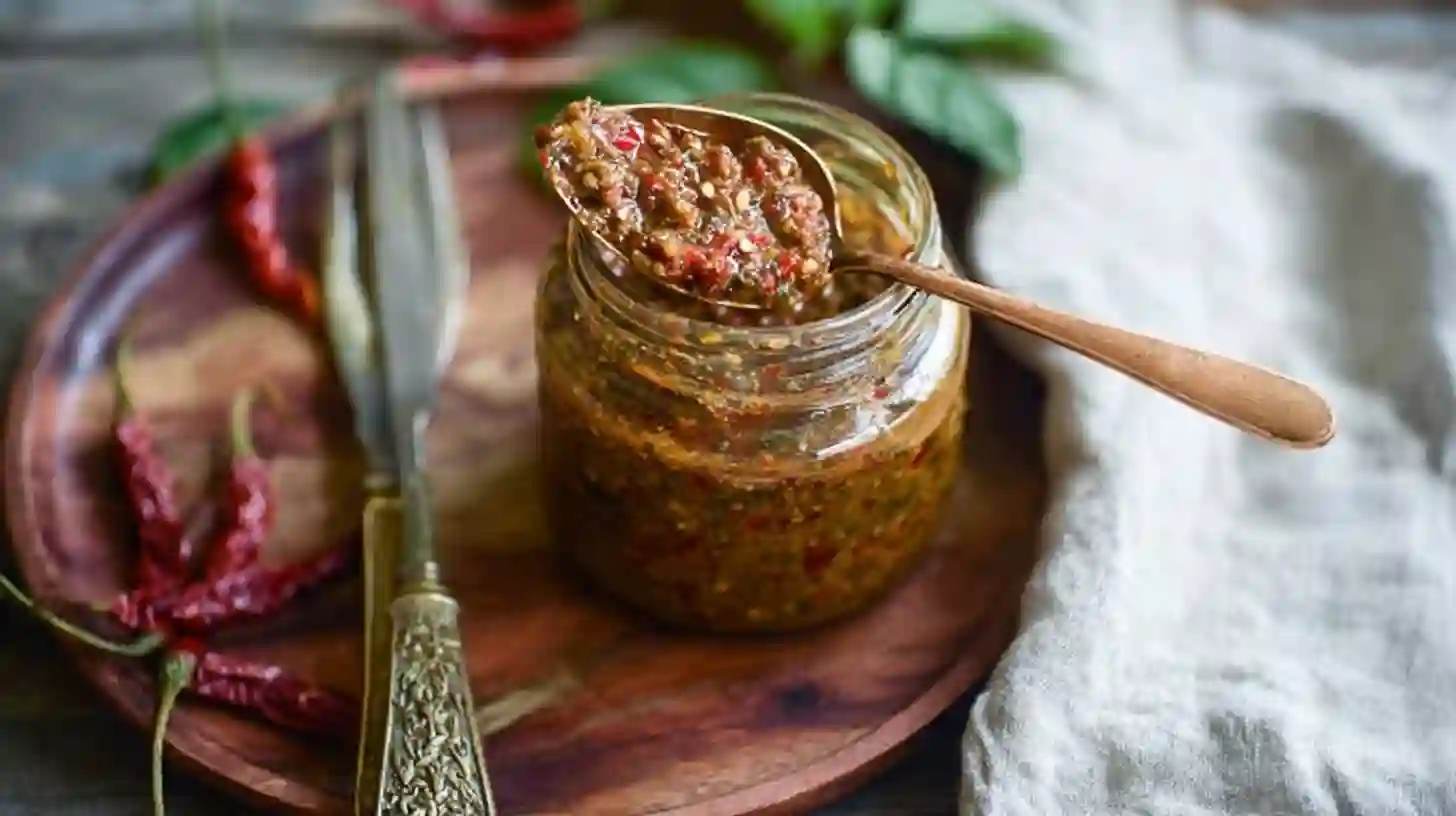
Tips and Notes
- If you’re using table salt instead of coarse salt, reduce the amount to between one and one and a half teaspoons.
- Choose fresh, high-quality peppers for the best flavor and heat.
- A sweet bell pepper softens the sharpness of the hot peppers, making the sauce more balanced.
- Vinegar adds just enough acidity to form a proper sauce without overwhelming the flavor.
- Keep the texture slightly chunky for a homemade feel.
- The olive oil layer on top acts as a natural seal to help preserve freshness.
Mastering Flavor and Heat Customization
Homemade hot sauce is all about making it your own. Here’s how you can adjust the flavor, heat, and texture to match your taste.
Adjusting Heat Levels
- Remove seeds and white inner ribs if you want less heat. These parts contain most of the pepper’s heat.
- Mix different pepper types to control intensity. Blend mild varieties with hotter ones to find the right balance.
- Add ingredients like carrots, tomatoes, or sweet bell peppers to tone down the spice.
- After blending, you can boost heat by adding chili powder or a few drops of chili extract.
Adding Sweetness
- Use natural ingredients like carrots, onions, or roasted garlic to add depth and subtle sweetness.
- Fruits such as mango, pineapple, peaches, or even blueberries can introduce a unique sweet-spicy mix.
- For a bolder sweet kick, try small amounts of honey, agave, or brown sugar. Always start with less and adjust to taste.
Introducing Aromatics and Spices
- Roasted garlic brings a mellow, rich flavor compared to raw garlic’s sharp bite.
- Caramelized onions offer sweetness, while raw ones add punch.
- Herbs like cilantro, mint, or oregano can bring freshness and lift the overall flavor.
- Try spices such as cumin, coriander, mustard seed, or smoked paprika for added complexity.
Vinegar and Acid Variations
- The type of vinegar changes the overall flavor. White vinegar gives a clean sharpness, apple cider vinegar adds a bit of fruitiness, rice wine vinegar is smoother, and red wine vinegar offers depth.
- Fresh citrus juice like lime, lemon, or orange can brighten up your sauce and add a fresh twist.
Flavor Combinations Worth Trying
- Smoky chipotle with garlic for a deep, bold flavor
- Fruity habanero paired with mango for a tropical blend
- Cayenne infused with roasted garlic and herbs for an all-purpose table sauce
Experiment and adjust with small batches. That way, you find your perfect combination without wasting ingredients.
Essential Equipment and Safety Tips
Making hot sauce is simple, but having the right tools and taking basic precautions will make the process safer and more efficient.
Kitchen Tools You’ll Need
- A high-speed blender or food processor to blend the ingredients smoothly
- A sharp knife and cutting board for prepping your peppers and herbs
- Saucepan if you plan to cook your ingredients
- Fine-mesh strainer if you want a thinner, smoother texture
- Funnel for mess-free bottling
- Kitchen scale for accurate measurements
- Clean jars or bottles for storing the finished sauce
Safety First When Handling Hot Peppers
Wear Gloves
Always wear food-safe gloves when handling hot peppers. Capsaicin can burn your skin and linger long after you’re done cooking.
Ensure Good Ventilation
Blending or cooking spicy peppers can release strong fumes. Work near an open window or use a fan to keep the air clear.
Protect Your Eyes
Avoid touching your face and especially your eyes. For superhot varieties like ghost peppers or Carolina Reapers, consider wearing goggles during prep.
Check pH for Preservation
To keep your hot sauce shelf-stable, it should have a pH below 4.6. Use pH strips or a digital meter to test your final product if you plan to store it outside the fridge.
Taking these precautions not only makes your kitchen safer but also helps you create a high-quality sauce you can enjoy and share with confidence.
Storing and Preserving Your Homemade Hot Sauce
To keep your homemade hot sauce fresh and flavorful, proper storage is key. Here’s how to do it the right way.
Refrigeration
Store your sauce in a clean, airtight glass bottle or jar and keep it in the refrigerator. Most homemade hot sauces will stay fresh for up to three months when kept cold. Always use a clean spoon when scooping to avoid introducing bacteria.
Understanding Shelf Stability and pH
For a sauce to be shelf-stable, it needs to have a pH level below 4.6. This level discourages harmful bacteria. For extra safety, aim for a pH between 3.5 and 4.0, which is ideal for homemade sauces stored outside the fridge. Use pH test strips or a digital pH meter to check this after blending.
Water Bath Canning for Long-Term Storage
If you want to store your hot sauce without refrigeration, water bath canning is a great method. Boil your filled, sealed bottles or jars in water for the recommended time to preserve them safely. Always follow trusted food safety guidelines for canning.
Choosing Bottles and Keeping Them Clean
Select glass containers such as woozy bottles or swing-top jars. Clean them thoroughly and sterilize before filling to prevent contamination. Using a funnel helps you transfer the sauce neatly.
How Flavor Improves Over Time
Letting your sauce sit for a few days or even weeks can help the flavors blend and deepen. Many hot sauce makers find that the taste improves after resting. Just give the bottle a good shake before each use.
Creative Ways to Use Your Homemade Hot Sauce
Your hot sauce isn’t just for tacos. Its bold flavor can elevate a wide range of dishes, both everyday and special.
Everyday Drizzles
Add a few drops to scrambled eggs or omelets
Spice up sandwiches, burgers, and wraps
Splash over pizza for a fiery twist
Top avocado toast or roasted veggies for extra punch
Cooking Applications
Use it as a marinade for grilled meats and seafood
Stir into salad dressings or dips for added heat
Blend with melted butter to make a homemade buffalo sauce
Add a spoonful to soups, stews, or chili to deepen the flavor
Gifting Ideas
Fill clean glass bottles with your hot sauce and create simple homemade labels
Add a handwritten tag with the sauce name and heat level
Include it in gift baskets alongside homemade pickles or spice blends
Homemade hot sauce is more than a condiment. It’s a way to bring extra life to your meals and a thoughtful gift that shows effort and creativity.
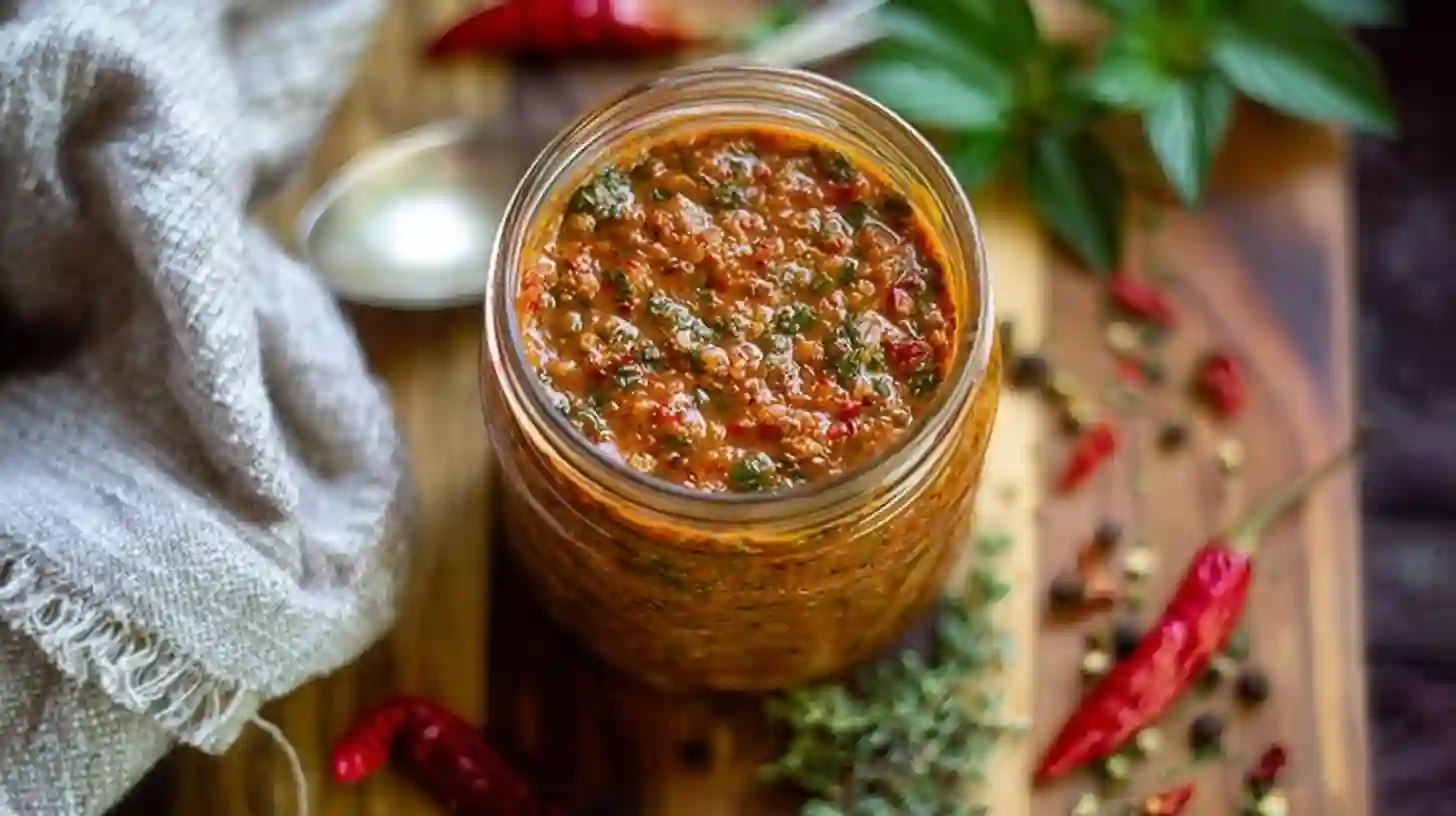
The Ultimate Homemade Hot Sauce Recipe
Ingredients
Method
- Rinse the peppers, herbs, and garlic. Remove stems from the hot peppers and the bell pepper. Remove seeds and white ribs from the hot peppers if you want a milder sauce.
- Place all ingredients in a food processor or high-speed blender: hot peppers, bell pepper, garlic, salt, vinegar, olive oil, cilantro, and mint. Blend until the mixture is chunky but well combined. Do not over-blend if you prefer texture.
- Spoon the mixture into a clean mason jar. Use a spatula to scrape down the sides and pack the sauce evenly into the container.
- Pour a thin layer of olive oil over the top of the sauce to help preserve freshness.
- Seal the jar tightly and refrigerate for at least 24 hours before using to allow the flavors to develop.
- Use your homemade hot sauce to spice up meals or give as a gift. Store in the refrigerator for up to three months.
Notes
Nutrition Facts (Per Serving)
- Calories: 23
- Calories from Fat: 18
- Total Fat: 2g (3% DV)
- Saturated Fat: 1g (6% DV)
- Sodium: 234mg (10% DV)
- Potassium: 53mg (2% DV)
- Carbohydrates: 2g (1% DV)
- Fiber: 1g (4% DV)
- Sugar: 1g (1% DV)
- Protein: 1g (2% DV)
- Vitamin A: 171IU (3% DV)
- Vitamin C: 22mg (27% DV)
- Calcium: 4mg (0% DV)
Conclusion
Homemade hot sauce brings together bold flavor, fresh ingredients, and complete control over the heat and taste. It’s simple to make, easy to customize, and far more satisfying than anything from the store.
With just a handful of ingredients and a few easy steps, you can create a sauce that reflects your style, whether you want something fiery and bold or smooth with a hint of sweetness. The added bonus is knowing exactly what’s in your bottle.
If you tried this recipe, leave a comment and a star rating below. Share your favorite pepper combo or tell us how you used your sauce. Did it end up on tacos, pizza, or something totally unexpected?
Feel free to pass this recipe along to fellow spice lovers or save it to your Pinterest board. Homemade hot sauce is a fun kitchen project worth repeating and perfecting. What flavor twist will you try next? Let us know.
Want to try a different style? Visit our habanero hot sauce for more spicy creations.
Frequently Asked Questions
How do I create my own hot sauce?
Start with fresh hot peppers, garlic, vinegar, and salt. Blend them until you reach your desired texture. From there, you can add herbs, sweeteners, or spices to customize the flavor. Store the sauce in a clean jar and refrigerate.
How long does homemade hot sauce last?
When stored properly in the fridge in an airtight container, homemade hot sauce can last up to three months. Adding a layer of oil on top helps extend freshness.
Why is my hot sauce too thick or too thin?
If your sauce is too thick, add a splash of vinegar or citrus juice to thin it out. If it’s too thin, try blending in a cooked carrot or roasted pepper to give it more body.
Can I use frozen peppers?
Yes, frozen peppers work well. Just let them thaw before blending. Keep in mind that the texture may be slightly softer than fresh peppers.
Does hot sauce get less spicy over time?
Sometimes. The flavors may mellow as the ingredients blend, especially if stored for a long time. However, the overall heat level usually remains noticeable.
What can I do with leftover pepper pulp?
Don’t toss it. You can dry it out and grind it into a seasoning powder or mix it into soups, marinades, or even homemade rubs for grilled meats.
Taking Your Hot Sauce Hobby to the Next Level
Perfecting Your Recipe
Keep experimenting with different pepper combinations, acids, and aromatics. Taste each batch carefully and take notes. Adjust quantities one step at a time to fine-tune flavor, heat, and consistency.
Basic Branding and Labeling
If you plan to share or sell your sauce, start with a catchy name and clean label design. Include ingredients, heat level, and a fun description. Use waterproof labels for a professional finish.
Scaling Up for Bigger Batches
Once you have a recipe you love, consider preparing larger quantities. Look into commercial kitchens or co-packers if you plan to sell. These facilities help maintain quality and meet food safety standards.
Food Safety and Legal Requirements
Before selling, check your local food safety laws. Some regions require licenses, inspections, or specific kitchen setups. Understanding these rules will help protect your brand and customers.
Advice from Experienced Sauce Makers
Many seasoned makers suggest starting small and staying consistent. Test with friends and family before going big. Keep your recipe simple at first and let quality ingredients shine. As one hot sauce maker put it, “If you love the sauce, others will too.”






